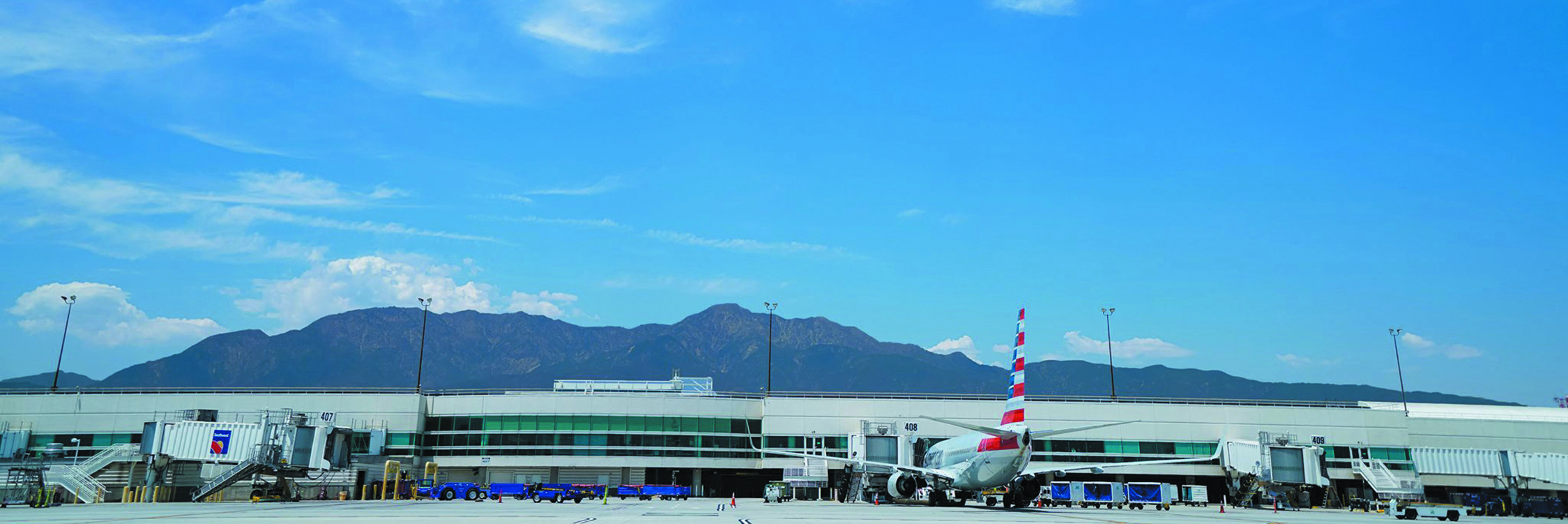If the story of Ontario International Airport (ONT) were a flight path, it would point due upward — and fast. Now in its eighth year since returning to local ownership, ONT continues to build on an extraordinary run of growth and momentum that places it among the most dynamic and forward-looking airports in the country. At the heart of that growth: a powerful combination of strategic location, community commitment, and the kind of airline partnerships that are fueling unprecedented domestic and international expansion.
As of April, Ontario has recorded 50 consecutive months of year-over-year passenger growth — an astonishing streak that makes it one of just a handful of U.S. airports able to make that claim. ONT served 7 million passengers in 2024 and is on pace to exceed that figure in 2025, marking a 67% increase since the airport returned to local control in 2016.
“We are proud of the trajectory we’re on, and even more excited about where we’re headed,” said Atif Elkadi, CEO of the Ontario International Airport Authority (OIAA). “We serve one of the most dynamic economic and population centers in the United States, and that gives us a unique opportunity — and responsibility — to lead.”
Elkadi noted that the Inland Empire, already home to more than 4.5 million residents, is expected to grow by another million by 2050, according to the Southern California Association of Governments.
Factoring in drive times, more than 10 million Southern Californians live or work closer to ONT than any other airport.
“That’s the ONT advantage,” Elkadi said. “It’s So Cal. So Easy.”
Expanding horizons — across the map
That advantage has not been lost on the airport’s airline partners. What have been announced so far are two new key routes in 2025: nonstop service to Chicago O’Hare via United Airlines, and to Baltimore-Washington International Airport via Southwest Airlines. The latter marks ONT’s first direct connection to the greater Washington, D.C., metro area — expanding convenience for business and leisure travelers headed to the East Coast.
But the real takeoff this year is international.
In July, Volaris will significantly expand its Ontario operations with the launch of 14 new flights to three new destinations in Mexico: daily service to Los Cabos International Airport, plus additional routes to León/Bajío International Airport, in Guanajuato and Morelia International Airport in Michoacan.
These flights complement Volaris’ popular service to Guadalajara — now in its 11th year at ONT — and mark a significant milestone in making Ontario a true cross-border travel hub.
Meanwhile, ONT’s global reach extends even farther across the Pacific. In June, STARLUX Airlines launched new nonstop service between ONT and Taipei, Taiwan. Already flying to Los Angeles, San Francisco and Seattle, STAR- LUX’s decision to make Ontario its fourth U.S. destination underscores the airport’s growing status as an international gateway.
“Ontario’s strategic location within the Greater Los Angeles area positions us to better connect the diverse communities of Southern California to and from Asia in luxury and comfort,” said Walter Liang, chief passenger commercial officer for STARLUX. “It’s seamless travel — SoCal your way.”
STARLUX now offers four weekly flights between ONT and Taiwan Taoyuan International Airport aboard its next-generation A350-900 aircraft, giving travelers convenient access not only to Taipei but to more than two dozen Asian destinations across the STARLUX network.
A global gateway, a local impact
The story of ONT’s growth isn’t just about numbers or new routes — it’s about creating new opportunities for a region on the rise.
A 2022 study by Oxford Economics placed ONT’s annual economic impact at $3.8 billion, supporting nearly 28,000 jobs and generating $1.6 billion in annual visitor spending. That kind of contribution makes Ontario International not just a transportation hub, but one of the Inland Empire’s most important engines of economic development.
And the benefits extend well beyond the airport footprint. As international and domestic travel options expand, so too does the region’s appeal to businesses, investors, and tourists looking for new gateways into Southern California.
With major events like the 2026 FIFA World Cup and the 2028 Los Angeles Olympics on the horizon, the timing couldn’t be better.
Built for what’s next
As demand grows, so does ONT’s investment in infrastructure and innovation.
The airport has added 13,000 new parking spaces in recent years and introduced all-electric, clean-air shuttle service.
It also launched ONT+, one of the nation’s first free digital visitor pass programs, allowing non-travelers to greet friends and family at the gate or enjoy ONT’s award-winning dining options without a boarding ticket.
International arrivals have also become faster and more secure, thanks to the implementation of U.S. Customs and Border Protection’s Simplified Arrivals biometric screening and the opening of a Global Entry Enrollment Center — one of just six in California.
Meanwhile, plans continue to move forward on a new international terminal, which will ensure ONT can meet future demand with the same level of efficiency, comfort, and hospitality that travelers have come to expect.
A community-driven future
Ontario International Airport may be soaring on the global stage, but its foundation remains deeply local.
“This is not just an airport,” said Alan D. Wapner, president of the OIAA Board of Commissioners. “It’s a reflection of the region we serve — ambitious, growing and committed to excellence.”
Since the return to local control, that commitment has translated into real progress, steady investment, and an airport that continues to deliver on the promise of being Southern California’s airport of choice.
So, no matter why or where you need to fly in the future, ONT is here to make your travel in So Cal so easy. Visit So- CalSoEasy.com to start planning your next trip.


